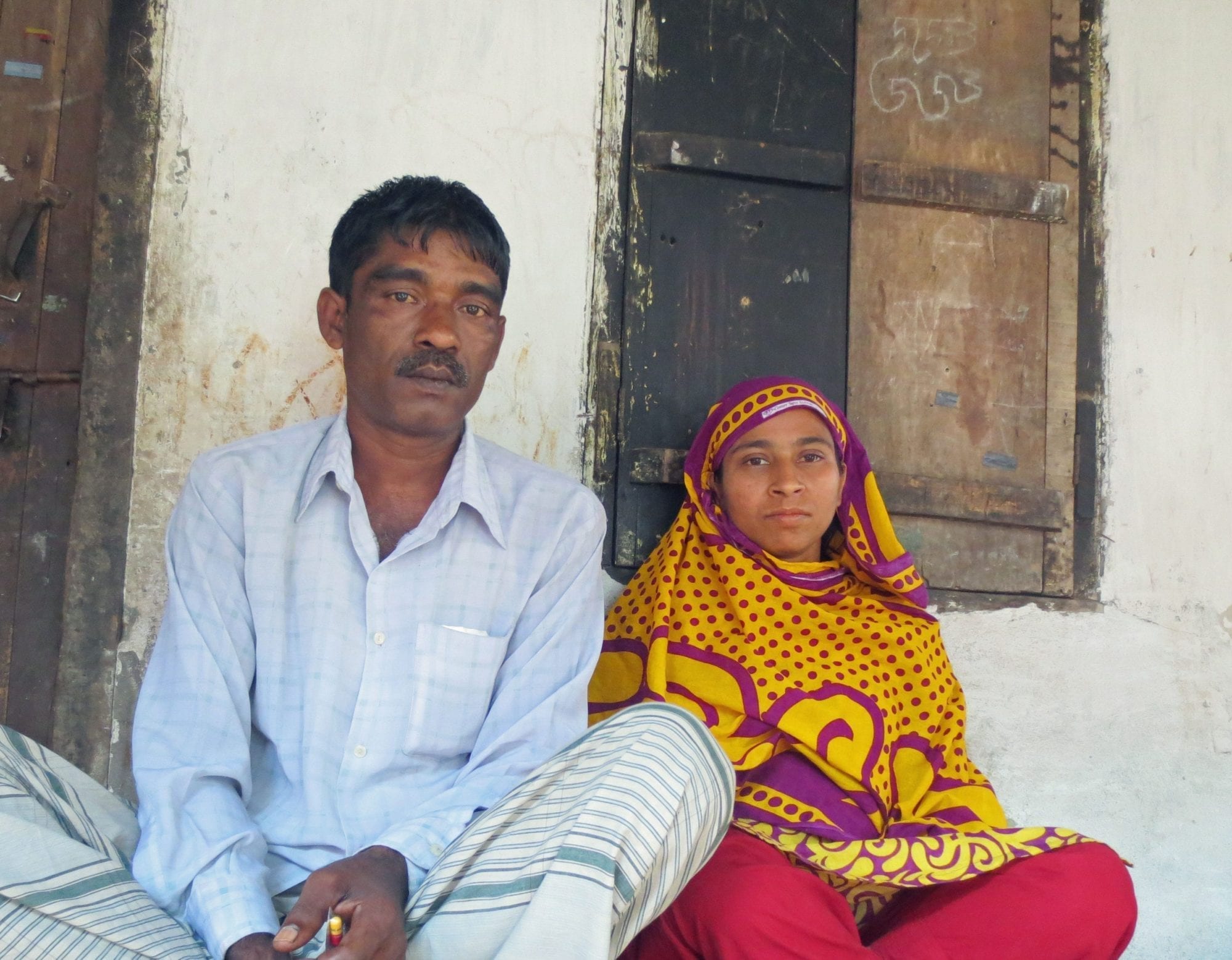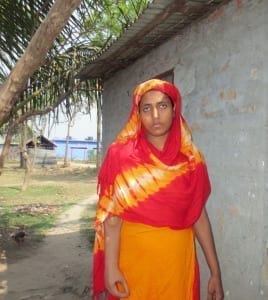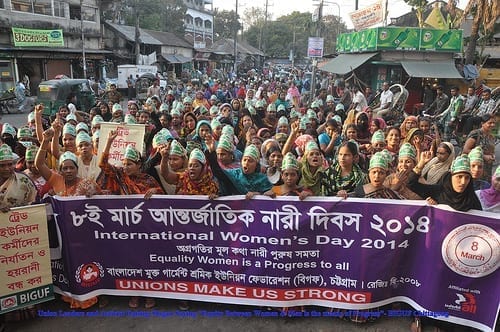
Apr 21, 2014
Most of the garment workers who survived the April 24, 2013, collapse of Rana Plaza in Bangladesh say they have been so physically injured and emotionally traumatized, they are unable to ever again work in a garment factory.
“Everybody is scared (to work) now (after the collapse),” said Hamida Begum, 28, who survived the disaster but suffers from constant pain in her right leg and eye. Yet garment factory work offers a rare option for millions of Bangladeshis to earn a living, and now Hamida is unable to contribute the wages needed to support herself and her family. “I am not educated and I cannot manage a good job,” she said.
Hamida, who was employed as a helper in New Wave Style, one of five garment factories in the Rana Plaza building, moved a few years ago to Dhaka, the capital, in search of a job. With overtime, she was paid between $60 and $70 a month. A year after the disaster, she still has received almost no compensation for her injuries.
“When the prime minister came to visit the victims in the hospital, I received $122 and a sari,” Hamida said. She received another $400 dollars from private donations.
Hamida’s husband earns between $1 and $2 a day, and the couple live with Hamida’s sister. They are unable to provide for their four-year-old daughter, who lives in a village with relatives.
She must take pain killers to endure the pain from her injuries. During the collapse, her head was injured and a gas cylinder fell on her right leg. More than 1,100 workers were killed and thousands more injured. Some bodies have never been found.
Hamida and her co-workers did not want to go into the Rana Plaza building on April 24. But they were told to report to work, despite the findings of an engineer the day before that no one should be in the building because it was structurally unsound. Hamida said as soon as the building generator was switched on, the building collapsed. She remembers one co-worker falling on her as she fell on two others. Then she lost consciousness.
The government should fulfill its responsibility to ensure that garment workers are not injured or killed at work, Hamida said. And if she ever met the factory owner, she would ask for sufficient compensation to support her family.
“If the owners are morally conscientious, then they should make an arrangement for us so that we can live a normal life.”
Apr 18, 2014

Moriom Begun survived the Rana Plaza collapse but lives in constant pain. Credit: Solidarity Center
When the multistory Rana Plaza building collapsed on April 24, 2014, in Bangladesh, Moriom Begum was trapped for two days in the room where she worked as a sewing operator. Hunched in the dark, unable to move beneath a sewing stool and suffering from serious injuries, Moriom was surrounded by the lifeless bodies of her co-workers. As the long hours dragged by, Moriom thought, “I will never see the world again.”
Moriom, who had worked for more than three years at New Wave Style, one of five factories in the building, lost her right hand in the disaster and suffers from continuous pain in her wrist. She recently was fitted with an artificial hand, but she says “the hand is very heavy. “This hand seems like an extra burden for me.”
Like many of the garment workers in Rana Plaza the day of the collapse, Moriom and her colleagues didn’t want to enter into the factory. The day before, engineers had identified cracks so serious they said the building should be closed immediately. But many factory managers threatened workers, saying they would be fired if they did not show up for work the next day.
More than 1,110 workers were killed and thousands more injured when the building pancaked. A government inquiry concluded that substandard construction materials and the vibration of heavy machinery in the five garment factories were prime triggers of the building’s collapse.
Moriom, 30, came to Dhaka, the Bangladesh capital, five years ago to provide her for her children. A single mother, she has returned to her village where she now looks after her parents and two children.
For the next few years, Moriom will receive enough monthly compensation from the Bangladesh government to support her family. To collect it, she must travel to Dhaka every month. But the money will eventually run out. She doubts she can ever work in a garment factory again and has set her hopes on launching a small food store.
“When people have their own hands, it is a big thing,” said Moriom. “The owners can get back money that they lost, but the workers won’t get back what they have lost.”
The government and the employers should understand the value of other people’s life, she said. If they value life, they will ensure that no more garment workers are injured or killed.
If Moriom had a chance, she would like to tell factory owners that they “should pay the workers according to the load of work you put on them.”
Despite her difficulty sleeping, her ongoing pain and her new caretaking burdens, Moriom remains positive because she expects her children will have a better life than she experienced.
“I may face lots of pain. But I hope my children will be educated and not face any problems in the future.”

Apr 18, 2014
Garment workers continue to be fired and harassed at the Taratex BD Ltd. factory in Gazipur, Bangladesh, according to the Bangladesh Independent Garment Workers Union Federation (BIGUF). More than 100 workers have been fired since they filed for union registration at the factory on February 4.
On Sunday, BIGUF says factory managers detained the new union president and general secretary and pressured them to immediately resign from their positions in the factory by signing previously prepared documents. They signed the documents after they were reportedly threatened, and were then removed from the factory.
The two leaders were elected after the factory terminated the union’s 12 executive committee members in the lead up to the union being registered on April 4. Six union members told BIGUF they have been forced to leave their homes for fear of their personal safety.
BIGUF is working with the factory union to file an unfair labor practice in addition to the one it filed in February 24. The federation says it remains “deeply concerned about the ongoing pattern of anti-union retaliation and mass terminations at Taratex.”
BIGUF is calling for immediate reinstatement and back pay for all workers who have been fired. Further, BIGUF says, authorities must send a clear message that terminations and other forms of anti-union intimidation are unacceptable, will not be tolerated and will be fully prosecuted in accordance with the law.
Feb 18, 2014
Garment workers and workers in other industries in Bangladesh’s export-processing zones are subject to a different, much weaker set of labor laws than workers in the rest of the country, and the government must take steps to reform laws so they meet international standards for freedom of association and collective bargaining rights, said A. K. M. Nasim, senior legal counselor at the Solidarity Center’s office in Dhaka, the Bangladesh capital. Further, “if we have any half-hearted reform in the legislation, it will mean that the workers will have to continue their struggle for a period of at least a generation to achieve these fundamental rights.”
Speaking at a recent forum in Washington, D.C., Nasim gave an overview of the current labor rights environment for Bangladeshis and provided key recommendations for improving their wages and working conditions.
Some 377,600 workers, the vast majority women, work in eight export-processing zones (EPZs) throughout the country.
Bangladesh derives 20 percent of its income from exports created in the EPZs, which are industrial areas that offer special incentives to foreign investors like low taxes, lax environmental regulations and low labor costs.
Yet while workers outside the EPZs are permitted to form trade unions, EPZ workers must form weaker workers’ welfare associations. Even though the associations have the right to bargain and negotiate agreements with employers, in practice, employers do not let the workers form their associations easily. Leaders of workers’ associations who actively promote the interests of the employees “have been fired from their jobs,” Nasim said. “As a result, most of the workers’ associations in the EPZs remain in existence only on paper.”
Nasim discussed the decision last June by the U.S. government to suspend Bangladesh’s trade benefits based on the country’s chronic and severe labor rights violations. The United States suspended its Generalized System of Preferences (GSP) agreement with Bangladesh after 112 workers were killed in a 2012 fire at the Tazreen garment factory, and more than 1,100 died last April when the Rana Plaza building collapsed. Since the GSP suspension, the Bangladesh government has allowed some 100 unions to register, in contrast with the few unions recognized prior to last year.
The Rana Plaza disaster also led to the Accord on Fire and Building Safety in Bangladesh, a five-year binding agreement between international labor organizations, non-governmental organizations (NGOs) and retailers in the textile industry to maintain minimum safety standards. The tragedies also have generated an increase in NGO involvement, and Nasim urged the NGOs working to improve workplace safety and health to support workers in forming and running unions, and making sure they are sustainable in the long run.
Also speaking at the forum, Solidarity Center Asia Regional Director Tim Ryan showed how the economic and political intersect in the Bangladesh context as described by Nasim.
“Bangladesh is a crucible for the intersection of globalization, the government’s economic policies, how these impact on the development of a democratic culture in civil society, and equitable and just economic growth that benefits workers and their families,” Ryan said. “A voice for workers in this process is absolutely crucial for growing democracy and democratic organizations in Bangladesh.”
The forum, “Strengthening Democratic Practices in Bangladesh: Empowering Workers in Export Processing Zones,” was sponsored by the National Endowment for Democracy and included Zerxes Spencer from the International Forum for Democratic Studies as moderator.
Nov 25, 2013
A year ago, 112 garment workers were killed in a fire at the Tazreen Fashions Ltd. factory—and a thousand others were injured in the scramble to escape a building with no fire escapes and firmly barred windows.
On April 24, 2012, more than 1,200 garment workers were killed when the multistory Rana Plaza building pancaked in, crushing workers in five factories located in the building.
If these workers, nearly all young women, had been in unions, it’s likely these tragedies could have been prevented.
These disasters—and many more smaller, little-reported workplace tragedies—are why Bangladeshi garment workers are literally organizing for their lives.
Because of the international attention these disasters sparked, workers now can register their unions.
But they are facing intense employer resistance—including physical attacks, threats and termination—and some of these young leaders could benefit from hearing from experienced trade unionists that the fight for a union is worth the struggle.
The workers would be strengthened by international support, knowing they are not alone. To send them a messae of solidarity, please use the sample letter below or write one of your own. Send the completed letter to [email protected] and let these workers know that you stand with them. The Solidarity Center, which has worked for 20 years to help Bangladeshi garment workers gain a voice on the job, will translate and distribute the letter to its union partners, and your message will reach the workers who need to hear it the most.
_____________________________________________________________
SAMPLE LETTER
Dear Sisters and Brothers:
As fellow trade unionists, we are writing in solidarity to commend your bravery and to encourage you to stand together in the face of employer resistance.
Since the tragic Tazreen factory fire in November 2012, you have made great progress in your efforts to organize. Even though ready-made-garment factory owners and the Bangladesh government have placed hurdles and difficulties in your path, you have persevered.
As union members, we know what this struggle is like. We know how hard employers fight to keep the union out, going as far as harassing and firing activists and leaders. Employers will try and turn you against one another.
We know from experience the struggle is worth the difficult journey—the union is the best way for workers to stand up for their rights.
Keep up your amazing effort and find strength in each other. Do not give up! We are with you!
In Solidarity,



